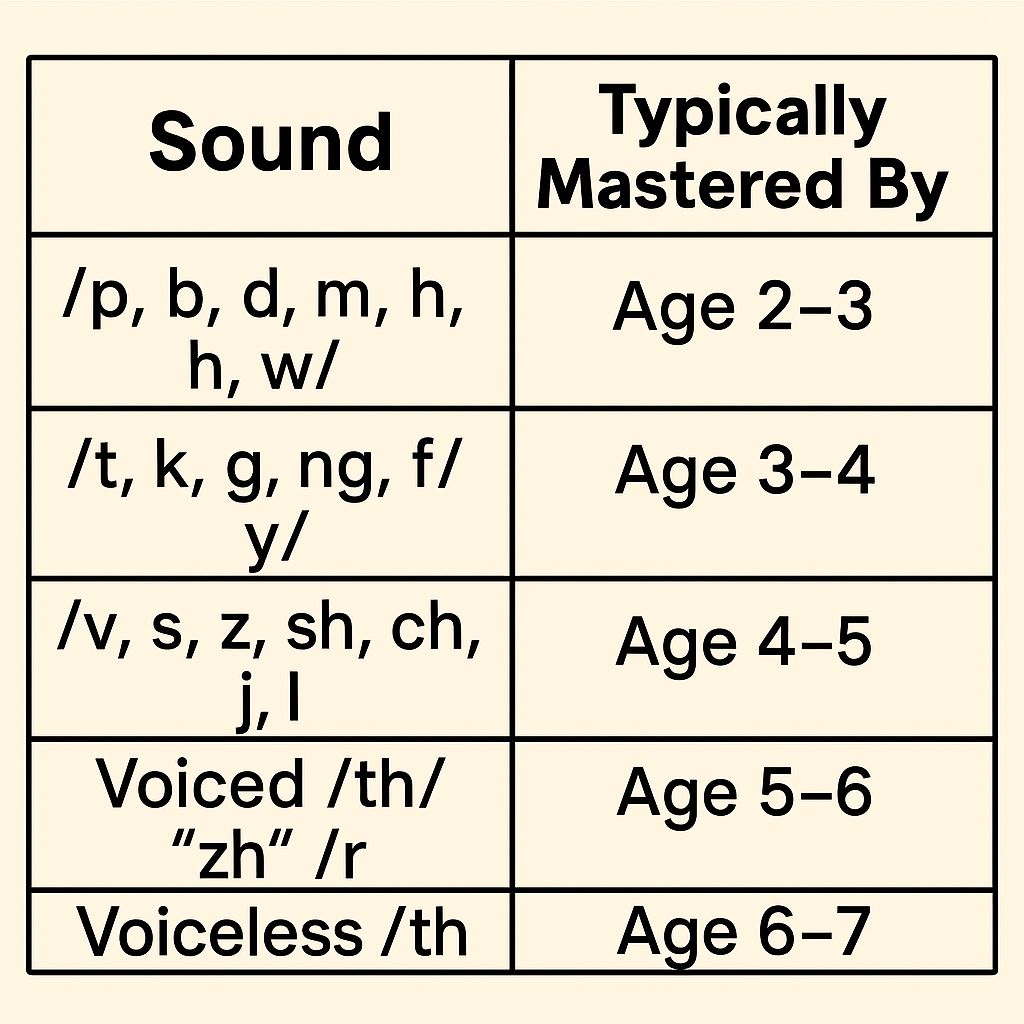Speech Sounds by Age
What’s Typical and When to Seek Help
As children grow and develop their speech, certain sounds emerge at expected ages. It’s perfectly normal for kids to make some errors as they learn to talk—but knowing what’s typical (and what’s not) can help parents support their child’s speech development and know when it might be time to check in with a speech-language pathologist.
Last week, we talked about Speech and Language Milestones. Check it out here. In this post, we’ll break down which speech sounds typically develop at different ages, and when certain errors—like lisps—may need attention.
⸻
Speech Sounds by Age
While every child develops at their own pace, here’s a general guide to when we expect kids to master specific sounds. These ages are based on typical development and may vary slightly from child to child.
Early Sounds (by age 3):
These are often the first sounds children learn to say.
• /p/, /b/, /m/, /n/, /h/, /w/ , /h/, /d/
• Example words: pop, ball, mama, no, hi, wow
Most children can say these sounds clearly by age 2 to 3.
Next Stage (by age 4):
These sounds come a little later as children develop more control over their articulators (lips, tongue, etc.).
• /t/, /k/, /g/, /f/, /ng/, /y/
• Example words: toy, dog, cat, go, fun, king, yes
By now, many children are producing most of these accurately, though some substitutions (like saying “tat” for “cat”) can still be common.
School Aged Sounds (by age 5):
By the time a child is entering Kindergarten, he or she should have these sounds.
/v/ /s/, /z/, /ʃ/ (“sh”), /ch/, /j/ /l/
Example words: van, sun, zoo, shoe, chick, jump, lion
If you hear errors on /s/ and /z/ that sound more like a “th”, like “thad” for “sad” or “thero” for “zero”, read on to learn more about lisps.
Later Sounds (by age 6–7):
These are trickier sounds that often take longer to master.
• /ʒ/ (“measure”), /r/, /θ/ (“th” as in thumb), /ð/ (“th” as in this)
• Example words: sun, zoo, shoe, treasure, love, run, think, that
It’s typical for sounds like /r/ and “th” to still be developing up through age 6 or 7. The /r/ sound, in particular, is often one of the last to be mastered.
⸻
What About Lisps?
Lisps are a type of speech error that affects the production of s and z sounds. There are a couple of types:
Frontal Lisp
This is when the tongue sticks out between the teeth, making a sound like “th” instead of “s” (e.g., saying “thun” for “sun”).
A frontal lisp is considered developmentally appropriate up to around age 4.5. Many children outgrow this pattern on their own. If it’s still present after age 5, it’s a good idea to consult a speech-language pathologist.
Lateral Lisp
This is when air escapes over the sides of the tongue, making the /s/ and /z/ sounds sound “slushy” or “wet.”
A lateral lisp is not considered typical at any age and often does not resolve without speech therapy.
⸻
Quick Reference Chart
While every child develops at their own pace, here’s a general guide to when we expect kids to master specific sounds. These ages are based on typical development and may vary slightly from child to child.
References: Crowe, K., & McLeod, S. (2020). Children's English Consonant Acquisition in the United States: A Review. American Journal of Speech-Language Pathology, 29, 2155–2169. doi: 10.1044/2020_AJSLP-19-00168
When Should You Be Concerned?
It’s time to consult a speech-language pathologist if:
• Sounds that should be developed are still missing or incorrect past the typical age
• You notice a lateral lisp
• Your child shows signs of frustration or avoids speaking
⸻
Final Thoughts
Every child is unique, but understanding typical speech sound development can give you peace of mind—or help you catch any red flags early. If you’re ever unsure, it’s perfectly okay to reach out for a speech evaluation. Early support can make a big difference!
Have questions or want to schedule a screening?
For more information on developmental norms, communication milestones, and when it might be time to seek help, visit the ASHA website .

